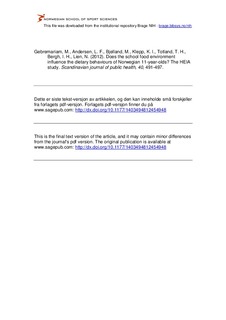| dc.contributor.author | Gebremariam, Mekdes K. | |
| dc.contributor.author | Andersen, Lene F. | |
| dc.contributor.author | Bjelland, Mona | |
| dc.contributor.author | Klepp, Knut-Inge | |
| dc.contributor.author | Totland, Torunn Holm | |
| dc.contributor.author | Bergh, Ingunn Holden | |
| dc.contributor.author | Lien, Nanna | |
| dc.date.accessioned | 2013-10-03T07:43:45Z | |
| dc.date.available | 2013-10-03T07:43:45Z | |
| dc.date.issued | 2012-07-24 | |
| dc.identifier | Seksjon for coaching og psykologi / Department of Coaching and Psychology | |
| dc.identifier.citation | Scandinavian journal of public health. 2012, 40(5), 491-497 | no_NO |
| dc.identifier.issn | 1651-1905 | |
| dc.identifier.uri | http://hdl.handle.net/11250/171114 | |
| dc.description | I Brage finner du siste tekst-versjon av artikkelen, og den kan inneholde ubetydelige forskjeller fra forlagets pdf-versjon. Forlagets pdf-versjon finner du på www.sagepub.com: http://dx.doi.org/10.1177/1403494812454948 / In Brage you'll find the final text version of the article, and it may contain insignificant differences from the journal's pdf version. The original publication is available at www.sagepub.com: http://dx.doi.org/10.1177/1403494812454948 | no_NO |
| dc.description.abstract | Aims: The aim of the study is to investigate the influence of the school food environment on the dietary behaviours of 11-year-old Norwegian children in elementary schools. Methods: Baseline data from a school-based intervention study: the Health In Adolescents study was used. A total of 1425 11-year-old children from 35 schools from the eastern part of Norway were included. School administrators provided information on the physical, political, and sociocultural school food environment and students reported their intake of fruits, vegetables, sugar-sweetened beverages (SSB), and snacks. Multilevel modelling was used to assess the school-level variance in dietary behaviours and to investigate the association of school food environmental factors with these dietary behaviours. Results: After adjustment for student characteristics, the school level accounted for a small proportion (1.1%–3.0%) of the variance in the dietary behaviours investigated. None of the investigated school food environmental factors were found to be related to the children’s reported intake of fruits, vegetables, snacks or SSB. Conclusions: Most of the variance in the dietary behaviours investigated was at the personal level. Thus in this sample, the investigated school-level factors do not appear to exert a strong influence on the dietary behaviours of children. Longitudinal studies using validated measures of the school food environment are needed. | no_NO |
| dc.language.iso | eng | no_NO |
| dc.publisher | SAGE | no_NO |
| dc.subject | dietary behaviours | no_NO |
| dc.subject | food environment | no_NO |
| dc.subject | multilevel analysis | no_NO |
| dc.subject | school | no_NO |
| dc.title | Does the school food environment influence the dietary behaviours of Norwegian 11-year-olds? The HEIA study | no_NO |
| dc.type | Journal article | no_NO |
| dc.type | Peer reviewed | no_NO |
| dc.subject.nsi | VDP::Medical disciplines: 700 | no_NO |
| dc.source.journal | Scandinavian journal of public health | |
| dc.identifier.doi | 10.1177/1403494812454948 | |
